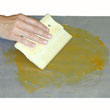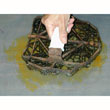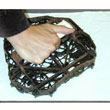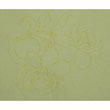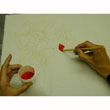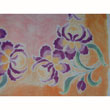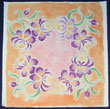Now that the dust from your mad dash to get the tjap (or tjaps) you wanted is slowly beginning to settle, you may be wondering what to do with the copper beauty sitting before you. Using Inko Resist makes for an easy batik project. As for the results, WOW! Beautiful, is it not?
Materials needed:
- Cotton fabric of your choice
- Batik Tjap (#TJAP)
- Procion MX Fiber Reactive Dyes (#PR)
- Sodium Alginate Thickener (#SA)
- Soda Ash Fixer (#FIX)
- Paint brushes
- Mixing cups (#CMC)
- Jacquard Waterbased Resist (#JWBR)
- Wood frame and push pins (#RRPP)
- Urea (#UREA)
- Professional Textile Detergent (#PTD)
Instructions:
1) Make soda soak solution by dissolving 1c. soda ash to 1 gal water. This solution can be saved and re-used until all used up.
2) Soak cotton fabric in soda ash solution for 5 minutes, then hang to dry so the fabric has no wrinkles.
3) Spread Cleanline Resist on a smooth flat washable surface (such as a foam plate or even a sheet of foil) with a spatula into a thin even layer the diameter of the tjap. Stamp the tjap into the resist and then onto the fabric. I recommend putting the fabric or garment on a folded towel so you have some "give" and can push and rock the Tjap a little while holding it down to get a good print. Repeat for each motif desired. Re-spread the Resist in between stampings if necessary to get an even layer. Touch up any lines with a brush and resist if your first stamping wasn't even. The leftover Resist can be scooped up and re-used if kept clean. Keep in an airtight container. Clean the Tjap with running water and a soft brush. Dry with a towel and allow fabric to dry thoroughly.
4) Mix sodium alginate ahead of time so it is nice and smooth when you're ready to add it to your dyes. 2 teaspoons to 1 cup of water works well. Also dissolve 1 tablespoon urea to this mixture.
5) Stretch fabric on a wood frame with push pins.
6) Next mix Procion MX Fiber Reactive dye using the following formula:
Dissolve 1 tablespoon Urea and from 2 to 8 teaspoons of dye powder to one cup of water depending on color and shade desired. If you are using smaller quantities, adjust amounts accordingly. Colors are always darker when wet. Mix your shades so you have them all ready to go.
Add your sodium alginate mixture to the dissolved dyes. Test by brushing onto a scrap piece of fabric for bleeding, add more sodium alginate mixture to thicken if needed. Dry with a hairdryer if necessary to check the shade.
You are ready to paint!
Keep the piece damp by placing plastic over parts already painted and starting to dry. The color develops best by staying slightly damp for 12 to 24 hours. For more information see "Cold Batch Method".
7) Wash by hand with detergent and rinse thoroughly after curing, air dry and iron if desired.









